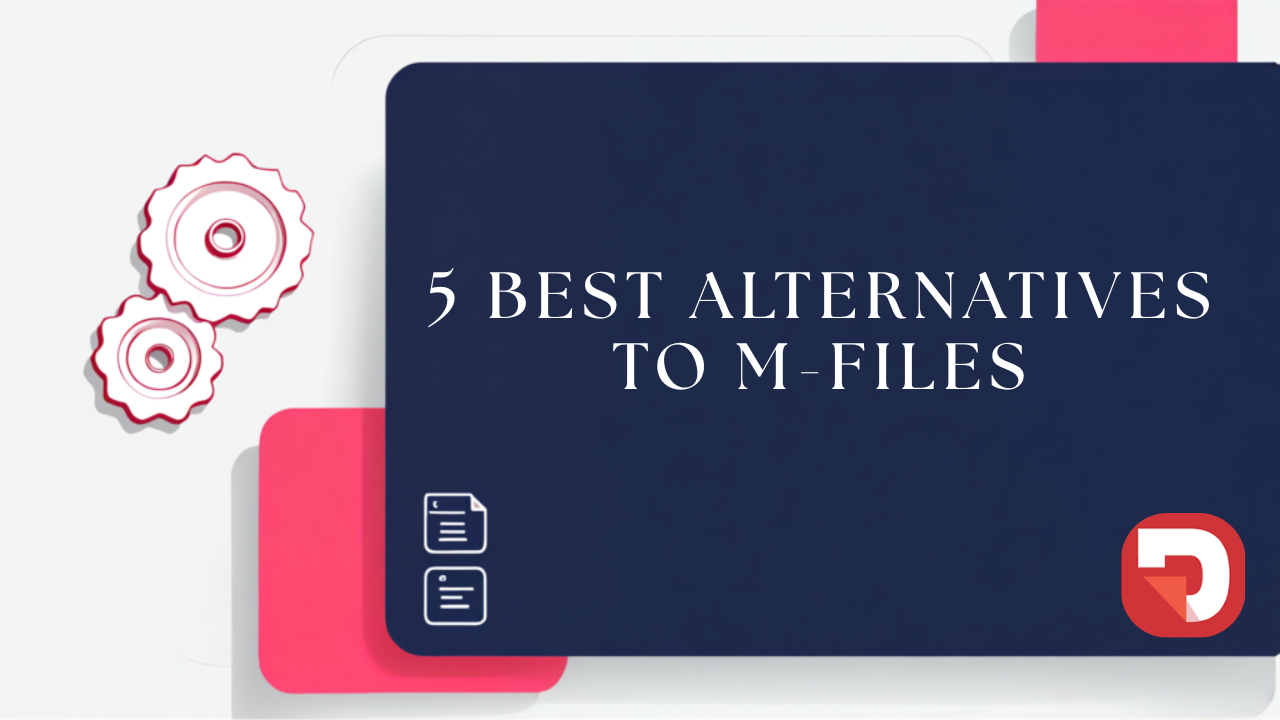
5 Best M-Files Alternatives for 2025
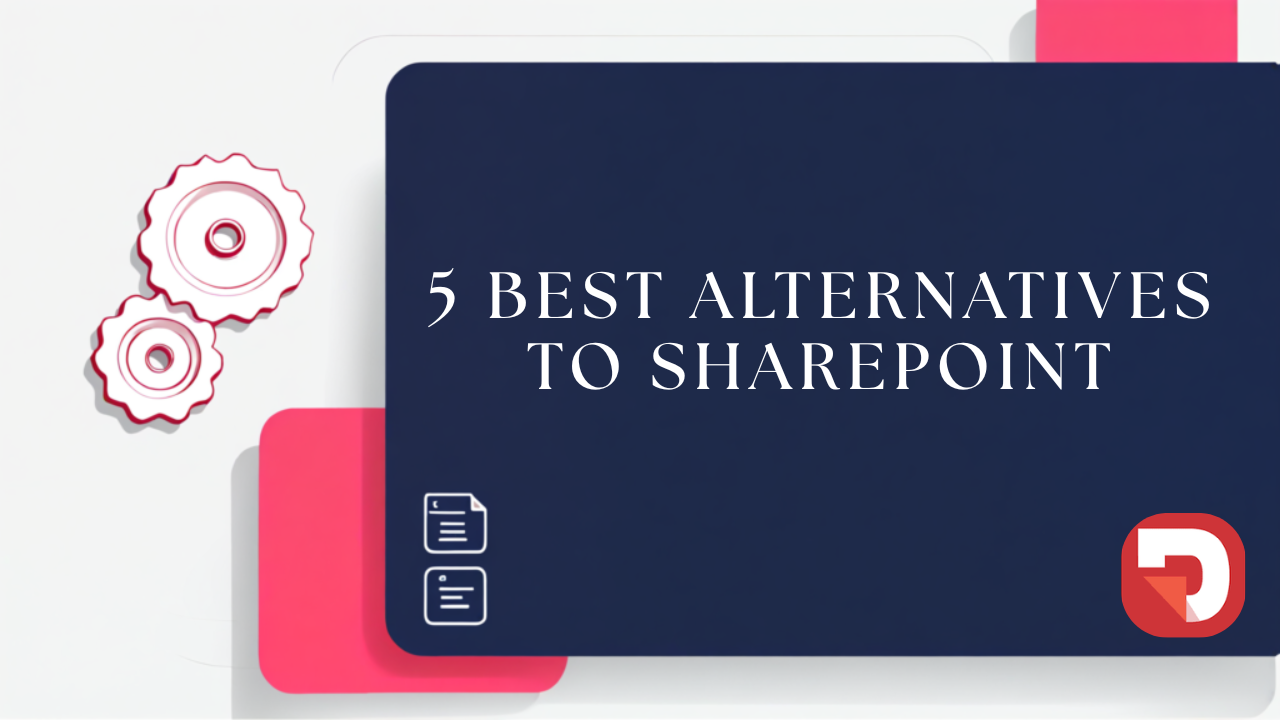
SharePoint is a DMS natively integrated into the Microsoft ecosystem. But what happens if you don’t use Microsoft products or want more powerful features? Check out the 5 best SharePoint alternatives.
SharePoint may seem like the best and easiest document management system if you’re already using Microsoft 365 products, such as Teams, Excel, PowerPoint, etc…
However, it is not the only one with strong (or native) integrations with the Microsoft package.
We’ll leave you with 5 Microsoft SharePoint alternatives to help you choose the perfect DMS and ECM for you.
Microsoft SharePoint with a document management system that is natively integrated in the Microsoft tool suite.
It offers centralized document storage that allows you to also creatte intranet sites, manage your files, share data, and collaborate across teams or with your clients.
SharePoint can be deployed either on-premises, through SharePoint Server, or in the cloud, via SharePoint Online as part of Microsoft 365.
Although bear in mind that if you are currently using or wish to use the SharePoint Server 2016 or SharePoint 2019, they will both be discontinued on July 2026.
The cloud-based DMS will continue to be available and updated regularly.
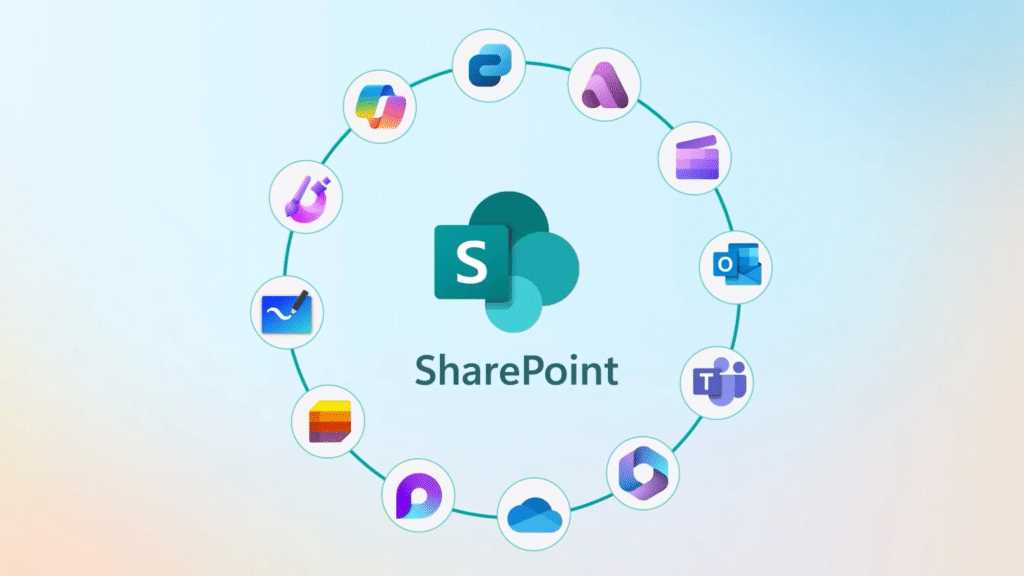
Although Sharepoint is a good solution, it also has some downsides that may have you looking for an alternative.
For starters, Sharepoint is designed primarily for the Microsoft ecosystem, and therefore lacks many integrations and customization features that other competitors such as Dokmee do include.
This tool is a good option for smaller businesses that rely on the Microsoft tool, but if you plan on growing your business, you should take into consideration that this is not a particularly scalable solution.
Finally, one of its major issues is that it still has a pretty outdated interface.
Although Sharepoint does have its downsides, it has many features that can be very useful, especially if you’re getting started with document management systems.
SharePoint’s intranet solution allows you to build sites and pages for specific projects where you can share information with your team and other departments.
You can build these sites with templates and tailor them to specific needs.
It acts as a single point of access where your team can find company news, policies, documents, tools, and resources.
These sites also have integrated search, permissions management, and workflow automation.
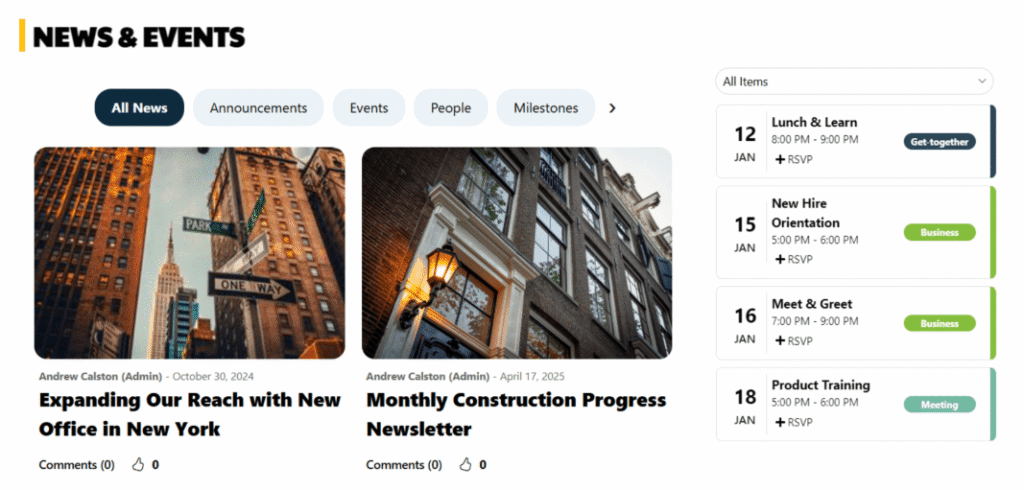
Source: Origami Connect
With Sharepoint you can store your documents in many different Bank Libraries that you can organize using metadata.
It includes version history that allows users to track changes, restore previous versions, and keep an accurate record of document edits.
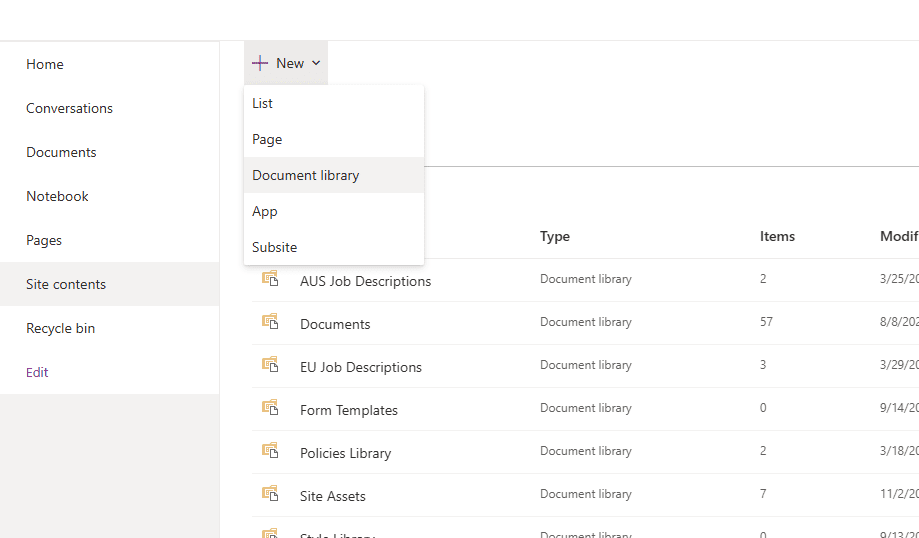
Source: Xoralia
Through Power Automate (formerly Microsoft Flow), SharePoint helps you automate repetitive business processes by building workflows that trigger actions based on specific events, such as document uploads, form submissions, or status changes.
Some tasks you can include are document approval processes, notifications for task updates, data collection from multiple sources, and automatic routing of information to relevant team members.
Workflows can be built with no-code automations and complex, multi-step sequences that connect with external systems and applications.
As we mentioned earlier, SharePoint isn’t really a scalable solution, as it tends to lag when it handles large amounts of files and libraries.
However, it is a good solution for small and medium business. Especially those who already rely on Microsoft products, as integrations will be seamless.
With automated workflows, SharePoint is a good option for remote teams that need to work together.
Its a good choice for small governments and educational institutions.
SharePoint may require dedicated IT support and customization efforts, so an IT teams might be necessary, particularly if you’re using an on-premise deployment.
Each of these platforms offers distinct advantages over SharePoint, depending on your organization’s priorities.
Dokmee stands out for its deep customization, advanced indexing, and flexible workflows, ideal for regulated industries.
DocuWare focuses on simplicity and ease of use, making it great for teams who want quick deployment without IT overhead.
M-Files brings intelligent, metadata-driven organization and AI-powered automation, offering a smarter way to manage information.
Laserfiche is built for scale and compliance, providing powerful automation and analytics suited for governments and large enterprises.
Finally, DocStar offers a balanced, practical solution with strong ERP/CRM integrations, making it perfect for SMBs and public sector organizations.
Compared to SharePoint’s more rigid structure and reliance on Power Automate, these alternatives provide more focused, efficient, and scalable document management experiences.
| Tool | Top features | Pricing | Who is it for? | Indexing and search capabilities | Automated workflows |
|---|---|---|---|---|---|
| SharePoint | Document libraries, team sites, basic metadata, Microsoft 365 integration, collaboration tools | Included in Microsoft 365 plans | Organizations already in the Microsoft ecosystem; collaboration-heavy teams | Standard metadata search; folder-based structure can become complex at scale | Power Automate required for advanced workflows; limited no-code options |
| Dokmee | Full DMS & ECM, advanced metadata, customizable permissions, OCR, e-forms, chatbot, modular workflows | Quote-based; mid-range | Medium–large orgs in regulated industries (finance, legal, healthcare, government) | Powerful, fully customizable indexing and metadata tagging for rapid retrieval | Drag-and-drop or advanced workflow builder; customizable triggers; Dokmee team can build complex flows |
| DocuWare | Secure document storage, Microsoft 365 integration, no-code workflows, version tracking | Subscription-based; mid-range | Small–mid-sized businesses needing simple, secure document routing without IT-heavy setup | Basic but reliable search and indexing; lacks native OCR | No-code workflow builder; simple to set up but less robust than Dokmee or Laserfiche |
| M-Files | Metadata-based storage (no folders), AI-powered classification, version control, audit trails, Microsoft native | Subscription-based; mid–high range | Medium–large enterprises with complex document lifecycles and compliance needs | Superior metadata search; AI auto-tagging and classification make retrieval fast and context-aware | Advanced workflows; AI-assisted automation; deeply integrated with Microsoft tools |
| Laserfiche | ECM + automation + analytics, native OCR, version history, granular permissions, analytics dashboard | Quote-based; enterprise-level | Governments, universities, financial institutions, large enterprises needing strict compliance | Metadata-driven indexing; OCR makes physical records fully searchable | Highly intuitive workflow builder; conditional logic; built-in analytics for performance tracking |
| DocStar | Cloud DMS, ECM, document capture, ERP/CRM integration, role-based access, workflow automation | Subscription; mid-range | SMBs & public organizations needing practical, scalable document capture and workflow tools | Solid indexing with OCR and metadata; integrates well with Outlook and Excel | Customizable workflows with triggers, decision branches, and notifications; fast to deploy without IT burden |
⭐⭐⭐⭐⭐ Ratings
G2 4.5/5 | Capterra 4.7/5
Overview
Dokmee is a DMS and ECM tools that offers full control and customization over your document management.
Dokmee can be tailored to every aspect of your document workflows, including user permissions and automation rules.
One of Dokmee’s biggest strengths is its powerful indexing and metadata management capabilities, which make searching and organizing documents fast and accurate.
The system supports fully customizable roles and permissions, allowing your administrators to clearly define access levels for teams, departments, or individual users. This ensures high compliance and security, particularly for regulated industries and reduces the risk of any security breach to a minimum.
Dokmee also includes version control and audit trails, so you can track every document edit, movement, or user action.
Regarding workflows, with Dokmee you can build detailed and triggering workflows with a no-code drag-and-drop builder or with a more advanced system.
However, if you need a more professional workflow but don’t have the IT team do it for you, you can turn do the Dokmee team to build it for you.
This flexibility gives it a major edge over SharePoint, which often requires significant configuration or third-party tools to achieve similar workflow sophistication.
Additionally, Dokmee offers a wide range of modular features, including:
Dokmee integrates seamlessly with Microsoft Word, PowerPoint, and email systems, which allows you to open, edit, and manage documents directly from their familiar Microsoft environment.
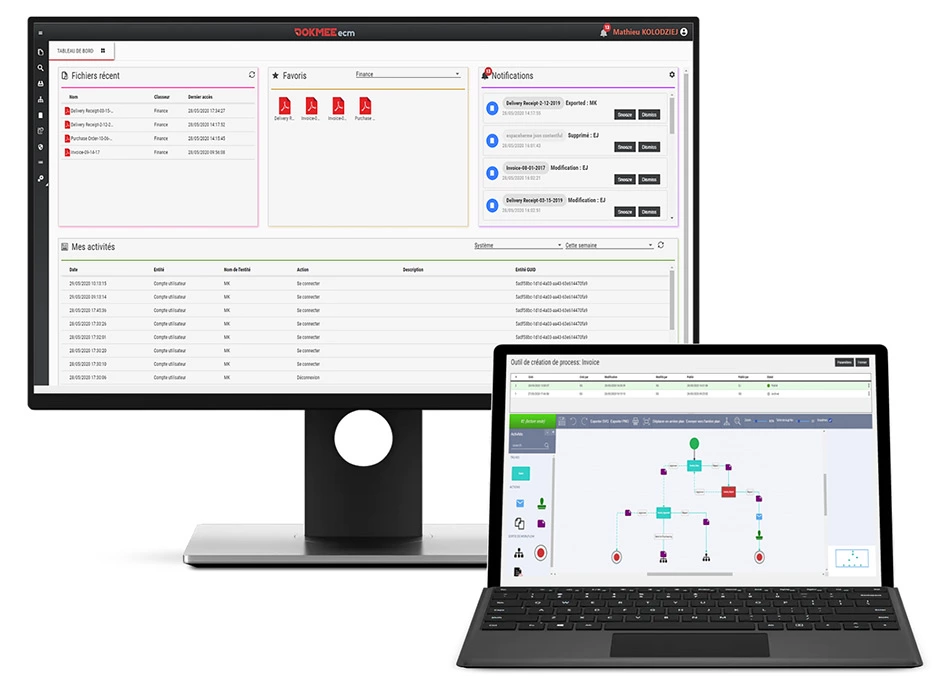
Why it’s better than Microsoft SharePoint
SharePoint falls short in usability, customization, and automation depth.
Dokmee, on the other hand, is completely customizable and doesn’t require heavy reliance on external developers or plugins. Simply design as you build your storage system.
Additionally, Dokmee offers many more options on workflows, automation, and role-based permissions.
Who is it for?
Dokmee is best suited for medium to large organizations that manage large volumes of documents, require strict compliance standards, or need to automate multi-step workflows.
It’s particularly valuable for finance, legal, healthcare, government, and education sectors, where accountability, document traceability, and workflow efficiency are top priorities.
⭐⭐⭐⭐ Ratings
G2 4.4/5 | Capterra 4.6/5
Overview
DocuWare is currently one of the most popular DMS tools. It focuses on document storage and workflow automation.
DocuWare is an intuitive and clean system that stores, organizes, and shares your files securely.
Similarly to SharePoint, it has a solid integration with Microsoft 365 tools, so it is a good choice if your organization uses tools such as Outlook, Word, or Teams.
However, it does not include native document capture or OCR capabilities. Meaning that if you need to scan, extract, and index data from paper or PDF files you would have to rely on third-party tools, adding cost and complexity.
DocuWare’s workflow builder is user-friendly and no-code. However, it’s not as flexible or technically robust as Dokmee’s dual-level system.
In terms of security, DocuWare includes role-based access control and version tracking, ensuring data integrity and accountability.
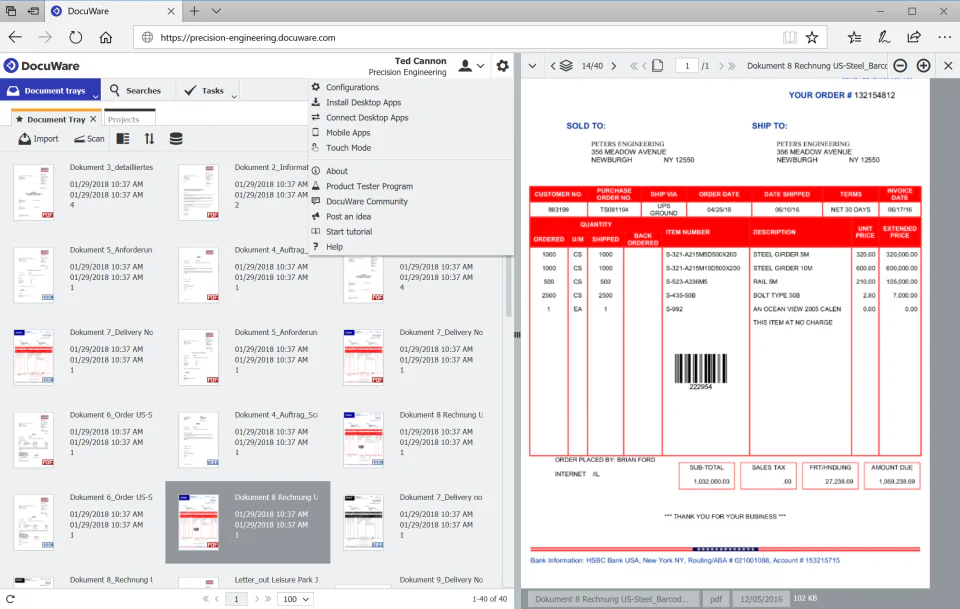
Why it’s better than Microsoft SharePoint
DocuWare offers a simpler, more focused experience for document management than SharePoint, particularly for organizations overwhelmed by SharePoint’s complexity and setup requirements.
Regarding the user interface, DocuWare is a cleaner and more modern system.
Unlike SharePoint, which mixes document management with collaboration spaces, DocuWare provides a dedicated, distraction-free environment for managing and archiving content.
Who is it for?
DocuWare suits small to mid-sized companies that need a simple and secure system to manage and route documents without heavy IT involvement.
It’s especially fitting for organizations who prioritize quick deployment and easy integration with existing Microsoft tools, rather than deep customization.
⭐⭐⭐⭐ Ratings
G2 4.3/5 | Capterra 4.4/5
Overview
M-Files is a DMS with a unique approach to document storage. M-Files doesn’t rely on rigid folder structures.
Instead, it uses metadata-based organization, allowing you to search, categorize, and retrieve files based on what the document is rather than where it’s stored. This unique system greatly enhances accessibility and ensures information stays consistent and discoverable across the organization.
This is a good fit for businesses who share the same documents across several departments.
Additionally, the platform also integrates natively with Microsoft 365 tools, including Word, Excel, Outlook, and Teams. This deep integration provides a smoother experience than SharePoint’s often-cluttered interface, while still maintaining full compliance and control.
M-Files also includes version control, audit trails, automated workflows, and AI-powered document classification, which help reduce time spent searching for files and improve accuracy in content management.
The main handicap for new users is the completely different storage and organization model. Since M-Files moves away from traditional folders, it can take time for teams to adapt.
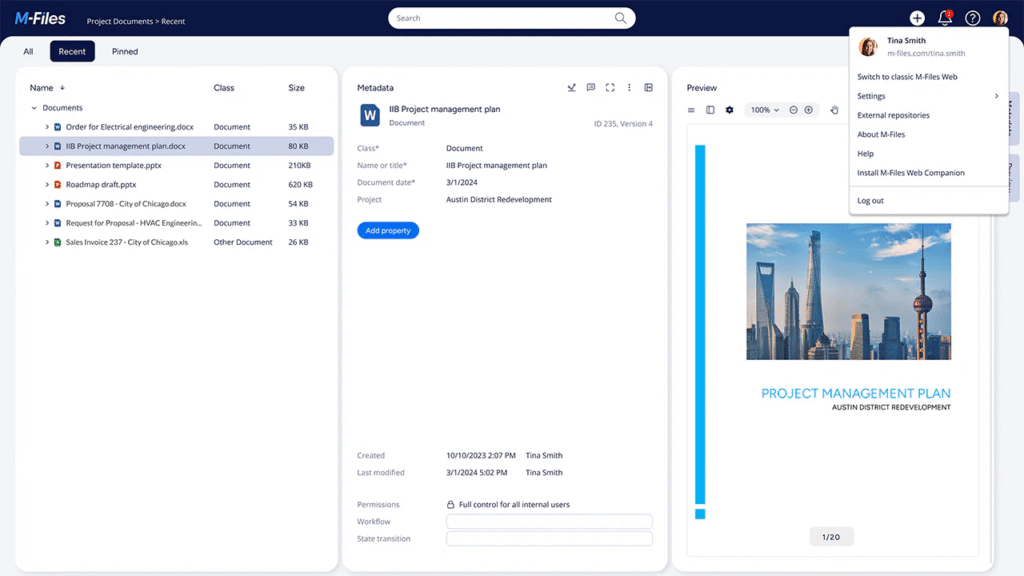
Why it’s better than Microsoft SharePoint
M-Files stands out as one of the most modern and intelligent alternatives to SharePoint, offering superior search capabilities and automation.
M-Files has built-in artificial intelligence that can automatically tag, classify, and suggest relevant documents, something SharePoint lacks without additional plugins or Power Automate flows.
The interface is cleaner and more modern than SharePoint’s, with more focus on usability and automation instead of site management.
Overall, M-Files provides a more intelligent, context-based, and automation-ready environment for document management.
Who is it for?
M-Files is ideal for medium to large enterprises with complex document lifecycles and strict compliance needs.
It’s particularly well-suited for consulting firms, engineering companies, financial institutions, and legal departments.
⭐⭐⭐⭐⭐ Ratings
G2 4.7/5 | Capterra 4.5/5
Overview
Laserfiche is a popular and well-established ECM that combines document management, workflow automation, and analytics tools.
It is designed with digital transformation in mind. Laserfiche focuses on helping organizations eliminate paper-based processes through intelligent automation and digitization.
Like SharePoint, it integrates with the Microsoft 365 suite (including Outlook and Teams), but offers a more simpler experience for document storage, retrieval, and process automation.
Laserfiche also includes native document capture and OCR capabilities, making it easy to scan and digitize physical records directly into searchable, metadata-driven repositories.
Among its features you can also find version history, audit trails, and granular permissions.
The platform’s analytics dashboard allows organizations to monitor workflows, identify bottlenecks, and continuously improve operations.
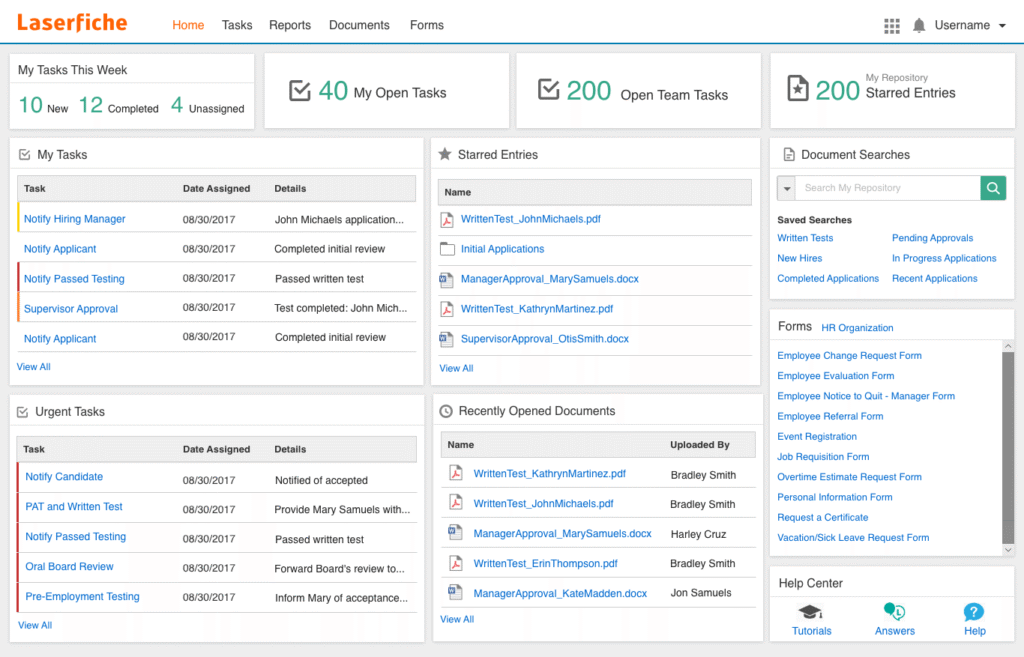
Why it’s better than Microsoft SharePoint
Laserfiche delivers a more cohesive and automated approach to document management than SharePoint.
Laserfiche’s workflow builder is more intuitive and offers more options to include conditional logic.
Laserfiche includes native insights to help measure productivity and workflow performance without extra integrations.
Who is it for?
Laserfiche is ideal for governments, universities, financial institutions, and enterprises that manage large document volumes and require certified compliance, auditability, and scalability.
⭐⭐⭐⭐ Ratings
G2 3.8/5 | Capterra 4/5
Overview
DocStar (by Epicor) is a reliable, cloud-based DMS and process automation platform built to simplify capture, storage, and document processing.
It is known for its ease of use and fast implementation. DocStar combines ECM tools with strong workflow automation, role-based access, and document capture.
The platform integrates well with Microsoft applications, including Outlook and Excel, allowing users to capture and manage content directly from familiar interfaces. Although its bigger upside is its integrations with ERP and CRM systems, giving it an advantage for organizations seeking end-to-end process automation.
DocStar’s workflow builder supports both simple and advanced automations, with customizable triggers, notifications, and decision branches.
While not as modern in interface design as M-Files, DocStar stands out for its practicality, reliability, and responsive customer support team.
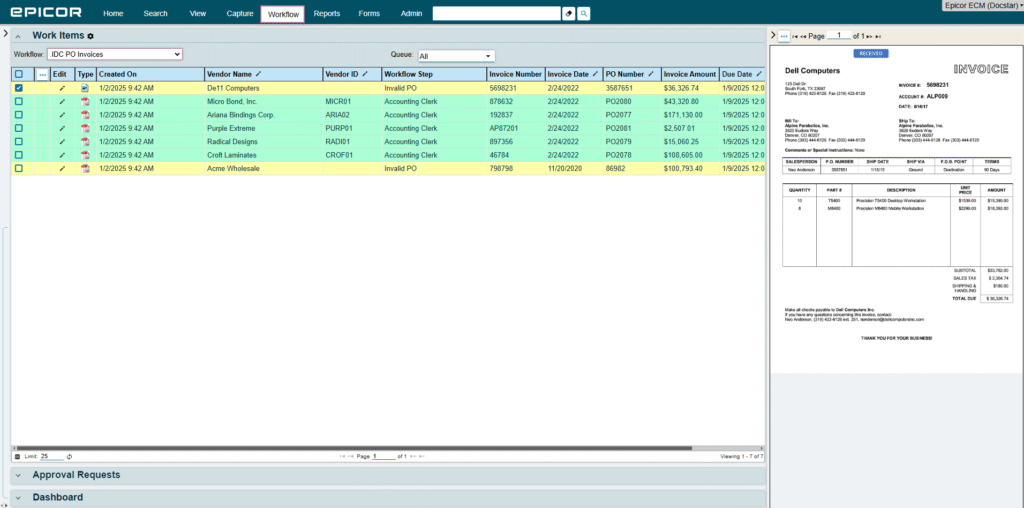
Why it’s better than Microsoft SharePoint
DocStar delivers more efficient document management for organizations looking to digitize and automate processes without heavy IT reliance.
DocStar is a better solution for industries such as finance, healthcare, and government operations who require structured workflows.
DocStar is not as deeply customizable as Dokmee or as AI-driven as M-Files, but it provides a balanced, dependable solution for companies that value simplicity, automation, and compliance over heavy technical complexity.
Who is it for?
DocStar is well-suited for small to mid-sized businesses and public organizations that want a practical, scalable system for document capture, approval workflows, and compliance management, without the overhead or complexity of enterprise-grade systems.
Choosing the perfect DMS or ECM platform for your business will define if you have an efficient, organized and well-run business or if your employees will spend countless hours looking for documents that may or may not be up to date.
While SharePoint offers many useful features like storage, intranet sites, workflow automation, and native integration with Microsoft 365, there may be better options for you.
Before choosing, ask yourself these 5 questions:
If you want a system that combines deep customization, powerful automation, and enterprise-grade security, Dokmee is your best choice.
From intelligent indexing to flexible workflows and full Microsoft integration, Dokmee helpls you manage documents efficiently, reduce risk, and enhance productivity across teams.
Do you want to know more? Book a demo now.